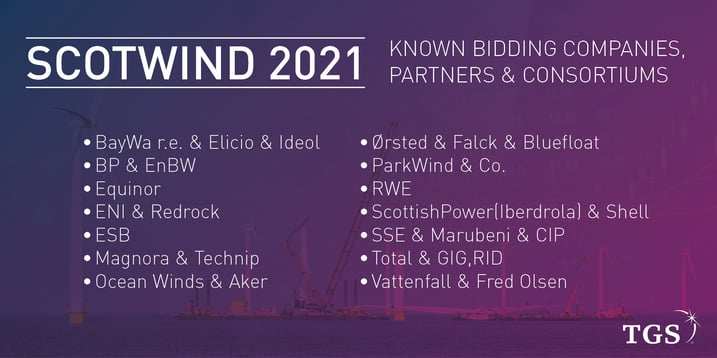| TGS insights give you the stories behind Energy data. These regular short 3-5 minute reads feature thought-provoking content to illustrate the use of energy data in providing insight, nurturing innovation, and achieving success. |
The winds of change are blowing offshore Scotland, and they are bringing with them hope for a strong future in renewable clean energy.
The long-anticipated bidding for the ScotWind leasing round offshore Scotland, United Kingdom, has closed. Crown Estate Scotland (CES) confirmed that applicants submitted an incredible 74 bids in the hope of securing seabed rights on 15 different areas, half of which will be best suited for floating wind turbines.
The lease round had been delayed, giving time to create and distribute a technical update to the option structure following the English Round 4 blind auction in February that brought higher than anticipated activity. This new option structure raised the maximum cost to £100k/ km2, bringing the values in line with those submitted in Round 4. With each bidder expected to be able to support this bid value, this suggests a potential total global investment pot for offshore wind projects running into hundreds of billions of US dollars.
 |
Join the ConversationAt TGS we create unique, actionable insights from raw energy data. These insights can reduce risks and enable a more detailed understanding of natural resource investments. Follow us to #SeeTheEnergy and JOIN THE CONVERSATION >> |
Provisional Bid Analysis
Bids are sealed, and details concerning bidding companies, their bid values and the leases of interest are not divulged until the confirmation of awards, currently not expected before January 2022. However, many have opted to publicize their interest. We have identified 14 companies and or partnerships that have divulged publicly their intent to bid through media releases. Many of these potential bidders have described their plans for establishing long-term roots in the Scottish offshore wind industry. These plans include improving the infrastructure of the electric grid in Scotland and plans to develop new technologies and create and retain jobs in the region.
The entities and partnerships that have disclosed their intent to bid are displayed in the graphic below:

The entities and partnerships that have disclosed their intent to bid in the ScotWind lease round.
Notable proposal highlights include the partnership between BP and German renewables firm EnBW. They have disclosed a plan to support a wind project with 2.9 gigawatts (GW) generating capacity. This partnership has already proposed a £40 million investment ($56M) in the Forth Ports planned Renewables Hub at the Port of Leith. BP’s EVP for gas and low carbon, Dev Sanyal, has also stated that his company would invest £10 billion ($14B) to help accelerate Scotland’s energy transition if successful with the bid. BP’s proposal would commit funds to develop new skilled workers and transition current O&G labor in addition to accelerating Scotland’s EV charging network.
It comes as no surprise to learn that Equinor has stated its intent to extend its footprint of floating structures through ScotWind. Currently, Equinor runs the 30MW Hywind floating farm off the northeast coast of Scotland, a trendsetter in the industry for efficiency, consistently producing the highest capacity factor among all UK offshore wind farms. Equinor hopes to leverage its floating wind farm expertise and dedication to renewable energy development to help Scotland meet their net-zero targets.
Other companies and partnerships include Irish utility and renewable energy developer ESB, REW, Shell, and ScottishPower Renewables. They have all stated that their bid proposals include a dedication to developing floating wind farms and innovating the Scottish supply chain for increased wind energy capacity.
A Net-Zero Ambition to Serve
The undeniable interest in the ScotWind lease is significant, and it illustrates the value offshore wind energy brings to accomplish the net-zero goals set by many governments and energy companies. ScotWind, with a ~10GW potential capacity, is the largest site-only lease round planned for the foreseeable future. The next largest site lease by capacity is UK Round 5 at ~8GW, planned for 2023-24. With so many energy companies publicly promising to meet net-zero energy goals by 2030, the pressure and competition to bring new projects online quickly is intense. These companies realize that the sooner they acquire acreage, the more likely they will be to accomplish these challenging goals. Notwithstanding the fact that the success of this round dramatically increases the possibility of a ScotWind 2, this lease round may offer the last opportunity for many companies to begin to fulfill their stated net-zero goals by 2030. It is believed that a shortage of concrete lease opportunities was a significant driver in generating the exceptional levels of activity and competition seen at ScotWind and last year’s English Round 4.
Even at an early stage, this lease round is already being considered a success due to the high levels of interest. Bid amounts are expected to reach maximum levels after the round closure delay, which was designed to allow bidders to increase their offers in light of the UK Round 4 results. Observers believe it extremely likely that the maximum bid of £100k/km2 ($140/km2) will be achieved for all awarded acreage. This will increase the need for ScotWind and the CES to evaluate the bids through a thoroughly rigorous process to determine the best candidates for each area. Submissions will have to go through a detailed scrutineering process. Their financial and technological proposal will be assessed against ScotWind’s comprehensive scoring guidance with those scoring highest most likely to be offered a lease.
The Scottish Factor
The bidding entities have expressed their interest in Scotland not only for the wind energy generating profits but also the opportunity to build a renewable infrastructure in a country that can be a showcase for what is possible in other areas. Equinor, with their partner SSE Thermal, proposes one of the UK’s first power stations equipped with carbon capture technology. At the same time, BP wants to rapidly expand Scotland’s EV charging network, build its hydrogen offering, and modernize ports and harbors. These companies also intend to leverage Scotland's significant and knowledgeable pool of skilled oil and gas technicians and laborers who are prime candidates for transition into the renewable sector.
These innovative companies see the opportunity to develop a robust renewable energy grid that can maximize Scotland’s offshore wind energy and bring it to market. This investment in energy innovation will help Scotland reduce energy costs and become a carbon-neutral energy innovator.
The perceived success of this lease round is expected to provide a boost to other global wind initiatives. Challenges such as the establishment of subsidy structures and energy grid dynamics, in addition to profit margin clarity, uptake in technological advancements, and conflicting regulations, have slowed progress in the past. However, as seen in the UK, these can all be overcome. There is now expected to be a renewed impetus by many governments as offshore wind becomes competitive and perhaps even cheaper than fossil fuels.
Beyond Wind Energy
Many in the sector are now aware that energy data on a large scale is at the center of establishing successful wind operations. The process requires an abundance of financial and scientific data and predictions covering the entire process, from bid submission to first energy transmission. Energy data companies such as TGS are beginning to provide the industry with a wide range of data types to help wind farm developers and their investors fully analyze their potential projects and most efficiently achieve their ambitions. Infrastructure and development data is available to scrutinize best practices. Numerical weather prediction (NWP) models validated against real-world measurements can be used to predict future returns and support investment decisions. Valuable sub-surface data such as seismic and multibeam data ensure the best sites for underwater structures are established. Ocean and weather dynamics, shipping route analysis, and environmental studies are all necessary to maximize energy efficiency while affecting the environment as little as possible.
The winds of change are here. Floating wind farms in the North Sea have shown the value wind can have on meeting energy demands and shaping and improving existing energy infrastructure, services, and employment. With the ambitious proposals that are expected of the ScotWind lease round, the country of Scotland will likely remain a beacon to other countries, demonstrating the benefits of a well-supported, stable and transparent wind industry.


